Truth matters. Community matters. Your support makes both possible. LAist is one of the few places where news remains independent and free from political and corporate influence. Stand up for truth and for LAist. Make your year-end tax-deductible gift now.
SoCal's Fantastic, Forgotten Railway To The Clouds
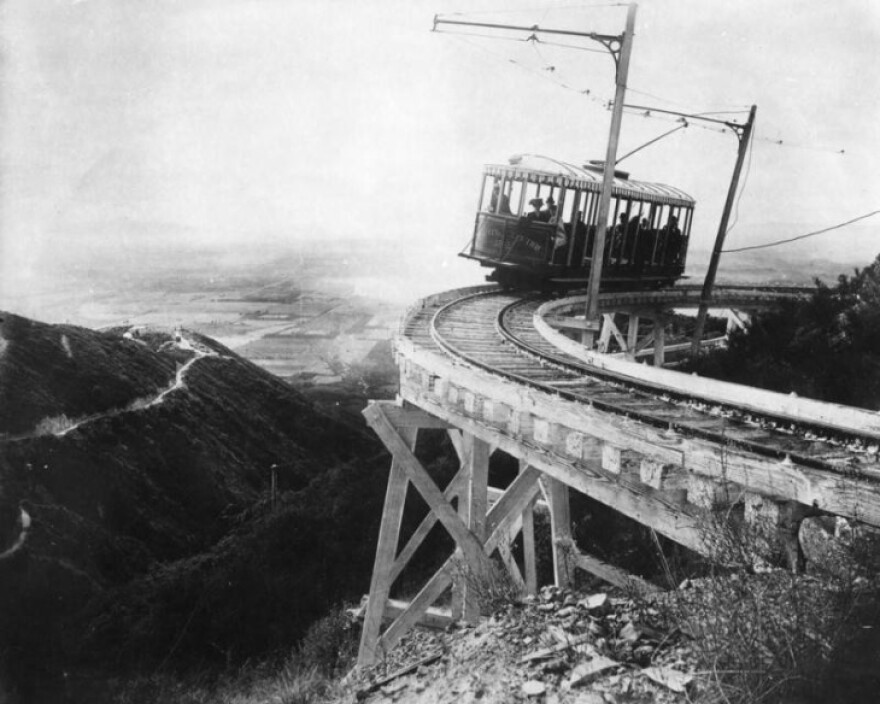
They called it the Railway to the Clouds. Sitting in an open trolley car, ascending through 4,000 feet of the San Gabriel Mountains, it must have felt otherworldly. You'd brush past pines and oak trees, chaparral and wild poppies at every precarious twist and hairpin turn. Finally, after a two-hour journey from Pasadena, you'd reach the summit where you could step out and enjoy breathtaking vistas, of the Pacific Ocean on one side and the San Gabriel Valley on the other.
Opened in July 1893, the 5.8-mile-long Mount Lowe Railway gave Southern Californians access to a glorious mountain retreat in the "American Alps." Visitors could take lengthy hikes, visit a small zoo, go horseback riding, play billiards or relax while gazing down at acres of citrus orchards broken up by dusty, little communities like Pasadena.
A trip on the Mount Lowe Railway was a chance to rekindle the frontier spirit and escape the hurly burly of increasingly industrialized late 19th century life. It was also a feat of engineering, made all the more jaw-dropping because it was conceived and designed by a man who never completed elementary school.
Inconsistent profitability and a series of debilitating natural disasters plagued the Mount Lowe Railway. It closed in 1938 and most Angelenos soon forgot about this gem. But Mt. Lowe Brewing Co., an upstart craft brewery run out of a former hot rod shop in Arcadia, is paying tribute to the marvelous mountain railway.

Brewing Up History
Shawn Nemanich and Mike Reiling met in 2007 and bonded over their love of cars. They tossed around the idea of opening a brewery -- but only if it was a side business.
"We both had our own businesses. We weren't really thinking about making money on it [a brewery]. It would just be cool to do," Nemanich says.
Although Nemanich had no experience making beer, Reiling had been home brewing since 2010, so they decided to take the plunge. They pushed the last hot rod out of Nemanich's shop on East St. Joseph Street and, in December 2016, they opened Arcadia's first craft brewery.
Inspired by their shared interest in local history, trains and the great outdoors, they named it Mt. Lowe Brewing Co., after the Mount Lowe Railway.

The brewery has so far produced 40 different beers including Inspiration Porter (named after Inspiration Point), Incline Ale (named after the Great Incline) and Honeyngton Hef (named after railroad magnate Henry Huntington). The taproom typically carries between 16 and 20 beers across a range of styles.
The brewery also keeps the history of the railway alive in ways that go beyond clever names for their beers.
"We wanted the look of the brewery to be vintage and to be an homage to the area," Nemanich says.
Nemanich's wife, Cami, who has worked as a costume designer, helped create a rustic vibe, stringing outdoor lights overhead and placing replicas of tabletop early 20th century gas lamps and lanterns around the room. The decor includes dark wooden booths and tables as well as large, framed prints of the old Mount Lowe Railway, which has a fascinating story all its own.
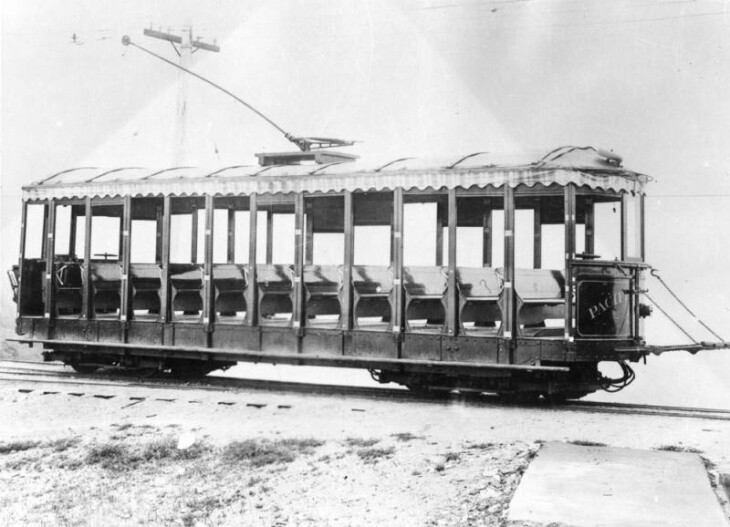
The Long And Winding Road
Born in 1832, Thaddeus Sobieski Constantine Lowe grew up on a farm in New Hampshire. Although he spent most of his time working the land with his siblings and was only able to go to school three months of the year, he was a voracious reader who was always hungry to learn. As a teenager, he took off to become an assistant to a touring chemistry lecturer. Eventually, he began lecturing on his own and declared himself a professor.
Lowe's first love was aviation and he dreamed of making a transatlantic flight in a hot air balloon. The Civil War interrupted that pursuit. When President Lincoln tapped him to lead the U.S. Army's Aeronautic Corp., Lowe distinguished himself. He would ascend in his military balloon over battlefields to report on troop movements. Along the way, he pioneered the fields of aerial mapping and photography.
In 1887, long after he had retired from the Army, Lowe moved his wife and 10 children to Pasadena, where he met civil engineer David Macpherson. The two men began pursuing a new dream -- to build a railway that would operate in the picturesque mountains high above Pasadena.
Before Lowe and Macpherson struck out on their own, they joined forces with several businessmen including Perry M. Green (president of First National Bank of Pasadena) to lead the Pasadena & Mount Wilson Railway Company. That venture was an attempt to build a railway to the top of Mount Wilson. Lowe acted as president and general manager while Macpherson served as chief engineer and construction supervisor. The trip to the summit from the bottom of Rubio Canyon, in Altadena, spanned more than 11 miles in the wilderness of the San Gabriel Mountains.

Lowe and Macpherson's involvement was brief. Almost from the outset, company execs were indecisive about what route they should take to the summit of Mount Wilson. Upon incorporation, the railway was overrun with "promoters" offering alternative routes.
It didn't help that the land atop Mount Wilson was owned by two individuals, who were both unrelenting in their negotiations with the company.

During this time, Lowe had asked Macpherson about an alternative location, one that would allow a railway using a cable line to operate and was a hospitable site for a mountain hotel. Macpherson looked over his surveys and selected Echo Mountain.
By December 1891, Lowe and Macpherson had resigned from the Pasadena & Mount Wilson Railway. They now set their sights on their own venture, their "Railway to the Clouds."
Striking Out On Their Own
Lowe and Macpherson decided to split their railway into three divisions. Passengers would start at the Mountain Division, on the corner of Lake Avenue and Calaveras Street in present-day Altadena. They would hop onto an open-air trolley that would ferry them through Rubio Canyon, nearly 2,000 feet above Lake Street, to the Rubio Canyon Terminal.
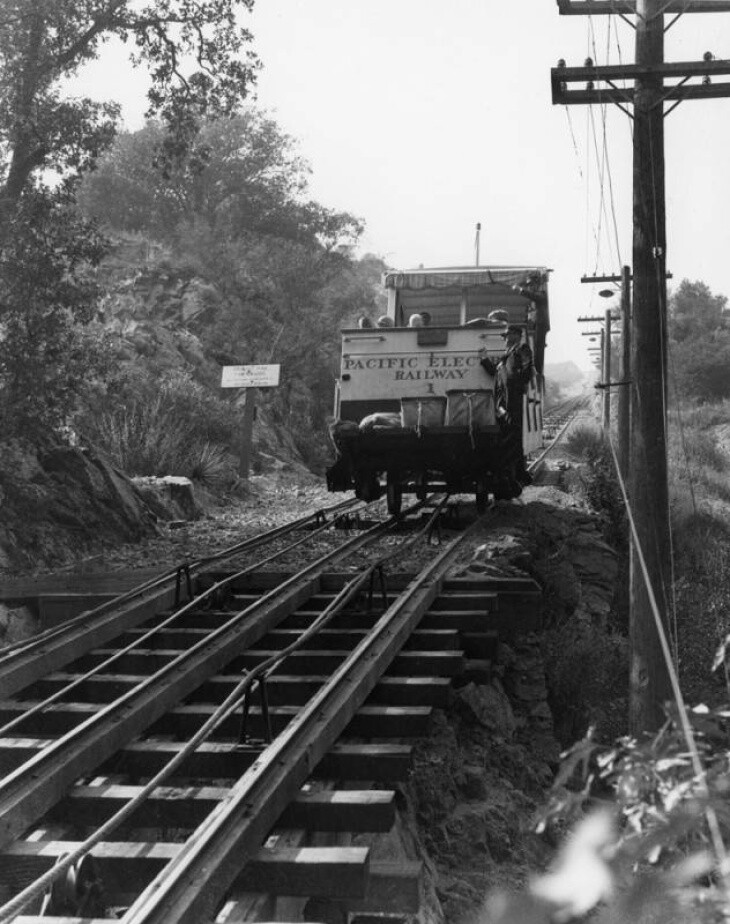
For the third leg of the journey, the Alpine Division, passengers would board an electric railcar at Echo Mountain. It would snake along a single track for nearly three miles until it reached the steps of Alpine Tavern.
Conductors would begin the final leg of the breathtaking trip with this speech: "Friends, you are now starting the last three and a half miles of this trolley trip on which you will cross 18 bridges and pass around 127 curves, the longest piece of straight track being but 225 feet in length."
Lowe and Macpherson had a vision. Now, they had to build it.

A Rocky Path
Macpherson was named chief engineer of the project. He and Lowe broke ground in December 1891 in present day Altadena, at the site of what would become the junction for the Mountain Division.
They faced numerous obstacles from the outset. The almost impenetrable rock that formed the wall of Rubio Canyon required near-daily blasting with sticks of dynamite. It took laborers 10 months to penetrate Rubio Canyon's hillside. Only then could they excavate and grade the roadbed, before laying rail and building the Rubio Canyon terminal. The construction effort also required workers to build nine bridges over deep ravines and tough terrain.
The timber used to build the Rubio Canyon Pavilion was ferried by ship from the Pacific Northwest to San Pedro before it was put on railcars, destined for Altadena.
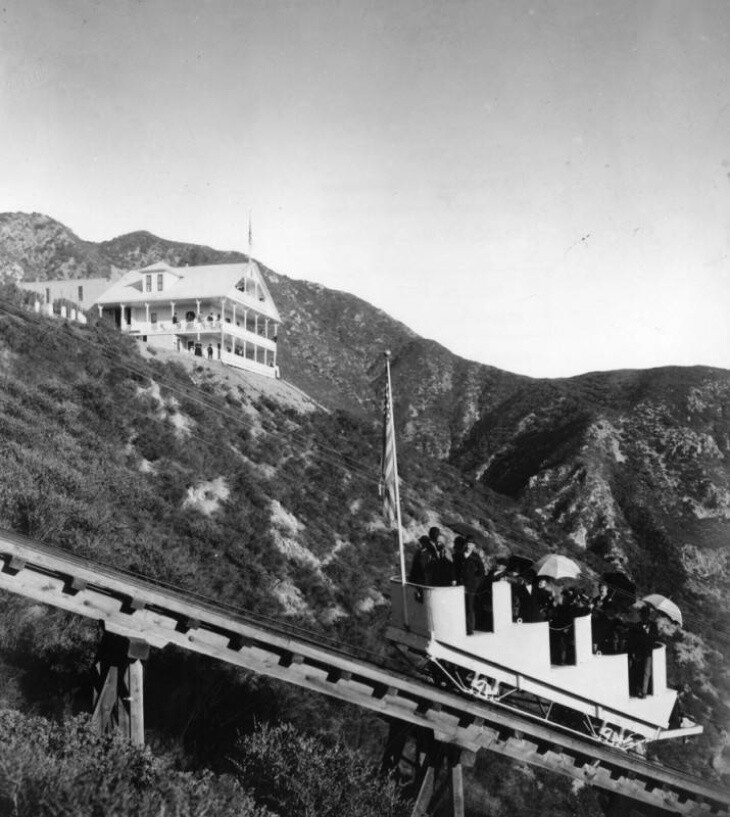
One of the most difficult obstacles for the builders of Mount Lowe Railway was the 3,000-foot Great Incline. It took laborers eight months to grade the incline -- which rose from a nerve-racking 52% grade to a staggering 62% -- and they had to do it by hand. It it was too steep for donkeys and the amount of weight the animals would've had to carry up the mountain was too much.
No matter. Construction never ceased.
Lowe and Macpherson faced a litany of geological challenges while grading and laying track in Los Flores Canyon. Macpherson's proposed route from the White City at Echo Mountain to Crystal Springs required months of dynamiting through sheer granite and rockface. Certain portions of the route, like Granite Gate, produced enough rock that workmen estimated they could build a city the size of Pasadena (back then).
The curve of the mountain, with its saddles and horseshoe-like bends, required Macpherson to engineer extraordinary features so the electric trolley could snake up steep and varying grades. Chief among these was Circular Bridge. Macpherson recognized the limitations of the conventional electric trolley, in particular its inability to properly function on grades steeper than 7%.
The engineer devised a clever turnback -- with one end being lower in grade than the other -- in the form of an almost 360-degree circular bridge jutting out from the side of the mountain. One curve of the nearly 400-foot-long circular track was noted for its staggering drop-off of 1,000 feet. Macpherson's ingenuity allowed a trolley car to maneuver through these mountain to its final stop, at Alpine Tavern.
When all was said and done, 127 curves were incorporated into the construction of the 3.5-mile long Alpine Division.

It didn't come cheap. The Mount Lowe Railway cost "three times as much per mile to build as any other mountain railway in the world," according to Charles Seims in the book Trolley Days in Pasadena.
Lowe and Macpherson also picked a bad time to start building. Early in 1893, just before Grover Cleveland was inaugurated as President, the U.S. economy began a downward spiral. People rushed to pull their money out of banks in what became known as the Panic of 1893. The resulting credit crunch rippled through the economy and a four-year depression gripped the country. During that period, 500 banks closed and 15,000 businesses failed.
Transportation ventures, including the Union Pacific Railroad and the Atchison, Topeka & Santa Fe Railroad, were hit hard. By the time the Rubio Canyon terminal and Great Incline opened on July 4, 1893, after two years of construction, Lowe had sunk a good deal of his own money into the project and was in a deep financial hole.
The remaining sections of the railway were still unbuilt. Over the next two years, Lowe had to sell construction bonds, liquidate some of his personal assets and secure loans to fund the last vestiges of his dream.
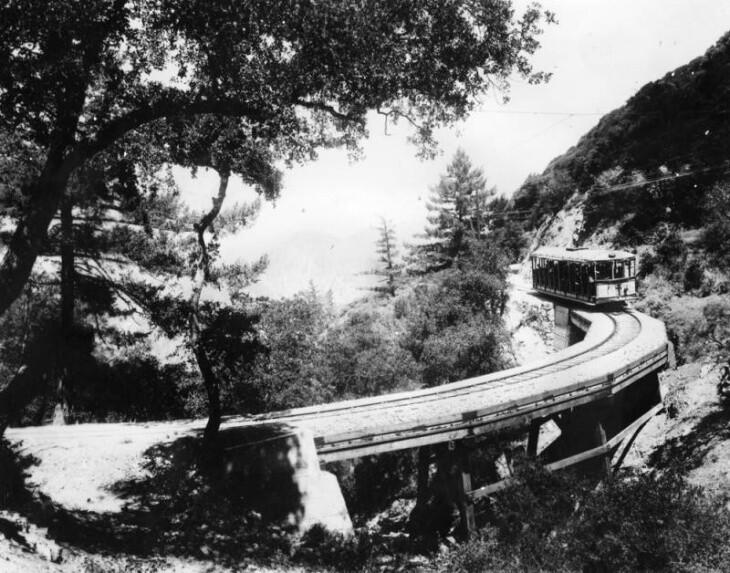
In Mount Lowe: The Railway in the Clouds, also written by Seims, he explains that Lowe, in order to fund the construction of the Alpine Division in 1895, mortgaged $30,000 on his home. A year later, due to the economic depression and the railway's lackluster revenue, Lowe had lost $100,000 from his personal holdings.
The crushing debt ended up bankrupting Lowe before the railway reached its full potential. The venture went into receivership and changed hands quickly.
In 1897, it went to a newly formed corporation named the Pasadena & Mount Lowe Railway Company. Then, in 1901, the Los Angeles Railway Company next took over the struggling venture. The following year, it was sold to Henry Huntington who already owned the vast Pacific Electric Railway traversing metropolitan Los Angeles and Southern California.
Huntington invested in much-needed track upgrades and maintenance. He introduced double-truck interurban railcars to carry more riders from Pacific Electric Railway's 6th and Main Street terminal in downtown L.A. At Rubio Canyon, he also swapped out the original narrow track for standard gauge, which would be able to accommodate heavier Pacific Electric railcars. In the Alpine Division, Huntington had his men replace many of the original bridge supports with cast concrete trestles.
Envisioning Los Angeles as a tourist hub, he marketed the Mount Lowe Railway as the "Grandest Scenic Trip on Earth." For a while, it looked like Huntington might make a success out of the railway.

That's Entertainment
At the summit of Echo Mountain, the terminus of the railway's second stage, passengers were rewarded with majestic views, hiking trails and fine accommodations. They could stay overnight at Echo Mountain House, a stately Victorian-themed hotel with more than 70 rooms. Thanks to the hotel's bright white exterior, which could be seen from the valley below, the area became known as the White City.
In addition to a Western Union office, the hotel contained a lady's drawing room, a barbershop, a billiard room and a bowling alley. The grounds had a museum, a working observatory and a zoo that showcased the area's native animals. Echo Mountain House was also famous for its massive searchlight, which was so powerful that The Star (a forerunner to the Pasadena Star-News) said it could "out-search anything ever constructed."
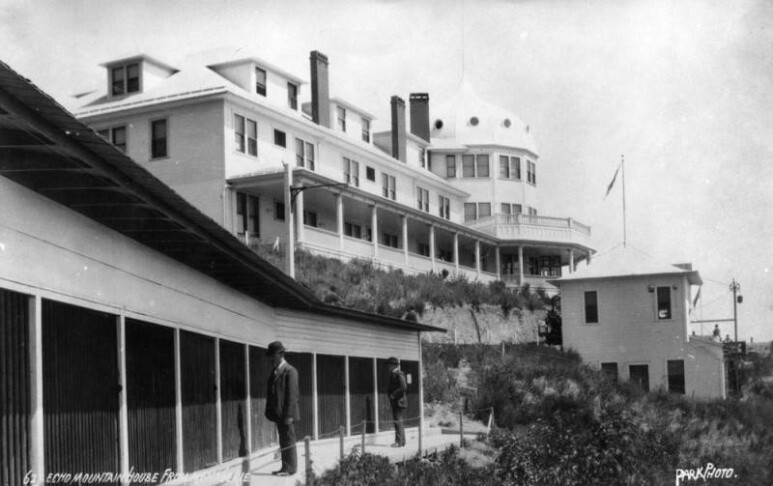
For passengers going all the way to the top, the final leg of the ride terminated at Alpine Tavern, a wooden lodge seamlessly integrated into the mountainside and surrounded by towering pine and oak trees. It had a lavish menu, with dishes like New York-cut dinner steak served with mashed potatoes or buttered turnips, and fried filet of sole with tartar sauce. It also had first-class rooms for overnighters. The entertainment options included a music room with a dance floor, a billiards room and a gift shop. One of Alpine Tavern's defining features was its spacious fireplace, which warmed the room where guests socialized in comfy rocking chairs.

Echo Mountain also provided a challenge for hikers. To reach the summit, you had to walk nearly three miles, to an altitude of 5,000 feet. It was a grueling undertaking. Even the most intrepid guests typically hired horses and mules to help them make the journey from the tavern to the peak. Less adventurous guests could enjoy easier day hikes around the tavern's periphery.
In the early 1920s, Alpine Tavern went through a series of renovations and expanded to accommodate more guests and deeper pockets -- a tennis court was even built -- and was subsequently renamed Mount Lowe Tavern.

The Mount Lowe Railway reached the peak of its popularity in the late 1920s, thanks to railcars that brought passengers from downtown L.A., Pasadena and points in between to Mountain Junction. During that era, the railway had nearly 100,000 visitors per year, spiking in the winter months when the San Gabriel Mountains received snow. But it always faced tremendous financial pressures as profitability waxed and waned.
A series of brush fires between 1906 and 1936 hurt the railway. A flash flood, in 1909, devastated it. The Mount Lowe Railway ran its last trip in December 1937.
By 1940, the railway and the hotels atop Mount Lowe and Echo Mountain had been abandoned. Metal, copper and brass from the railway was salvaged or stolen. The derelict railway faced persistent vandalism and theft. In 1941, ownership of the railway, its hotels and the land on which they were built reverted to the U.S. Forest Service and it became part of the Angeles National Forest.
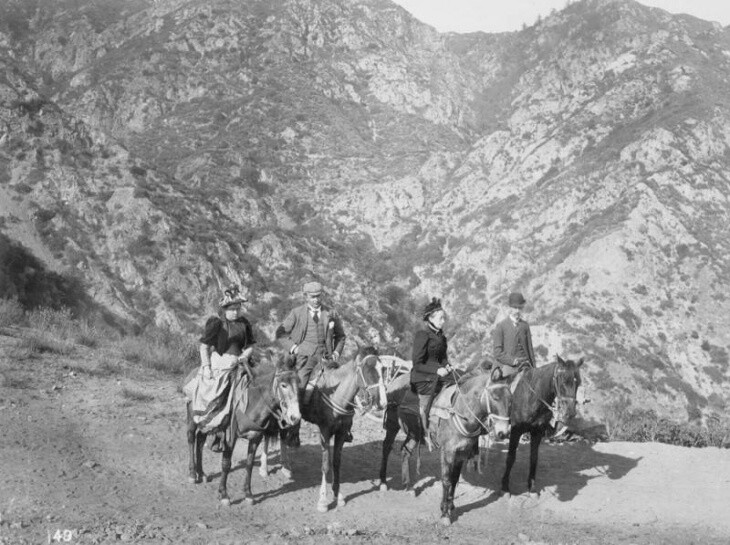
Except for a stranded grip wheel and Echo Mountain's eery chalet house, few remnants of Mount Lowe Railway ae still standing. It is kept alive in photos and placards along a popular hiking trail in Altadena, which starts at the Lower Sam Merrill Trail before intersecting with the Mount Lowe Railway Trail. Several organizations, including the Mount Lowe Preservation Society and the Altadena Historical Society, have helped preserve its history and artifacts.
Mt. Lowe Brewing co-founders Nemanich and Reiling want their establishment to educate people about the railway and mayeb inspire them to make the trek to Echo Mountain.
Nemanich says Mt. Lowe Brewing will continue to pay homage to Thaddeus Lowe's grand dream: "We hope that the little history lesson or a beer name or a picture inspires them to learn more."







